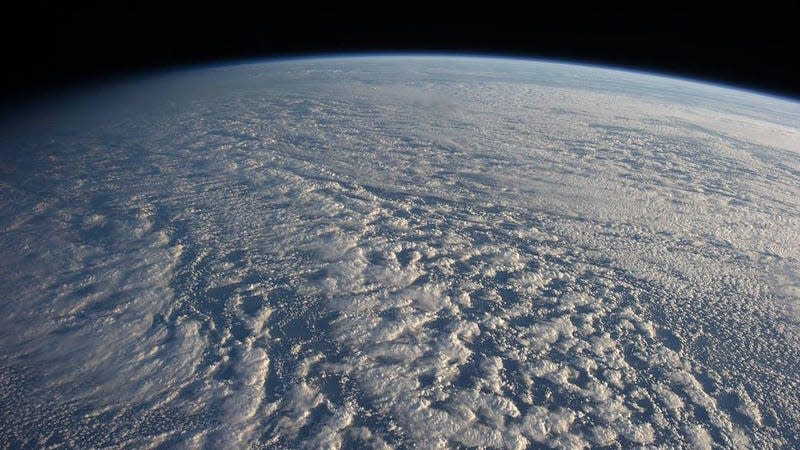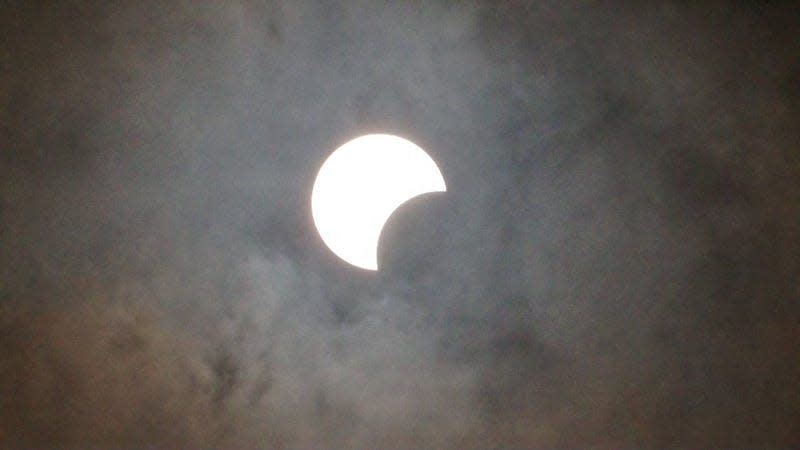Cloudy for the Eclipse? Here's What You Can Still See

The Great North American Eclipse is happening Monday, but given the latest weather forecasts, many people across the continent will look up and see nothing but clouds. Should that be the case, here’s what you can expect.
During totality, the Moon passes between Earth and the Sun, casting a shadow onto the planet. When gazing at this spectacle through clear skies, the Sun’s aurora, or atmosphere, becomes visible, the sky darkens to such a degree that stars are visible, and it gets discernibly colder. In the minutes before and after totality, odd shadows, called shadow bands, can be seen on flat surfaces.
It goes without saying that clouds can significantly lessen the beauty of this experience, but it’s not a total write-off; other aspects can still capture your attention, as Matthew Cappucci, a meteorologist and atmospheric scientist for the MyRadar app, told me.
“You won’t notice shadow banding, so you won’t notice anything weird on the ground, and you obviously can’t see the Sun or the Moon,” he said. “But you have a better opportunity to view the shadow coming in because now you have something for the shadow to be cast on.”
Cappucci said you might be able to see the Moon’s shadow sweeping across the sky and moving over the cloud cover, saying it’s “very weird” to look at, and that he saw this for himself during a solar eclipse in Chile four years ago. It becomes significantly darker, but apart from the overall dimming, there’s not much else to observe, he explained.
However, the strangest part is that, during the cloudy eclipse, on the edges of the shadow, it’s still a bit bright; so although you won’t witness a full 360-degree sunrise, you’ll notice the horizons appearing brighter, Cappucci said. This is especially strange because, while it’s incredibly dark and cloudy overhead, the horizon has a brighter cloud cover. “It looks very weird—like you’re in the middle of this ring,” he said.
When it comes to clouds, it’s also important to note their insulating effect on surface temperatures. Clouds act like a thermal blanket, trapping heat that would otherwise radiate into space in the eclipse’s darkness, Cappucci explained. Some of this heat is reflected back toward the ground from the clouds. As a result, places with cloud cover experience a less dramatic temperature drop compared to clear skies with dry air, where the temperature is more likely to fall sharply.
Other things to be on the lookout for during a cloudy total solar eclipse are a sudden change in the way the air feels and possible shifts in wind speed. And because it’s a bit darker, you may also notice some changes in animal behavior, such as birds returning to their nests or nocturnal animals becoming more active. And lastly, the final thing you’ll notice is that you’ll have no use for those eclipse glasses.

Now, if it’s partly cloudy and you get partial views of the Sun, you should still be in for a real treat. I learned this during the annular solar eclipse in October of last year, during which time I took some cool and spooky shots of the spectacle. So don’t be discouraged if partly cloudy conditions are in the forecast.
Whether you’ve got clear view of the Sun or if it’s obscured by clouds, the upcoming eclipse should still serve as a remarkable event to experience.
For more spaceflight in your life, follow us on X and bookmark Gizmodo’s dedicated Spaceflight page.

